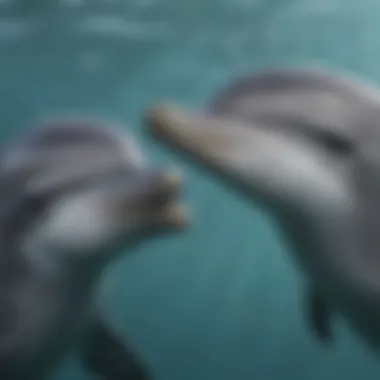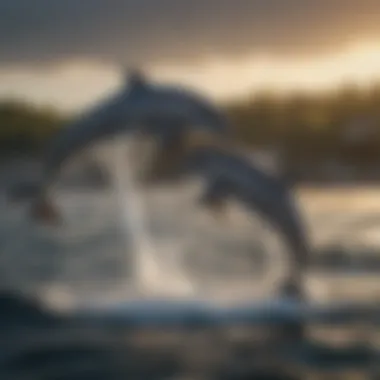The Complex Language of Dolphins Unveiled


Nature Topic Overview
Dolphins are fascinating marine animals, well-known for their intelligence and social behavior. Their communication systems are complex and varied, enabling them to navigate their underwater environments, develop social bonds within pods, and enhance their hunting techniques. Understanding how dolphins communicate is crucial for appreciating their role in the ocean ecosystem and is directly linked to efforts in conservation.
By examining the methods dolphins employ, such as acoustic signaling, echolocation, and behavioral cues, we gain insight into their lives. This exploration includes how these methods help them connect with each other and interact with other species, including humans. As this article unfolds, it will highlight the key components of dolphin communications and their significance not only to the dolphins themselves but also to the marine world at large.
Fun Facts and Trivia
- Dolphins can recognize themselves in mirrors, showing their high level of self-awareness.
- They can produce over 1,000 distinct sounds, which include whistles and clicks.
- A group of dolphins is called a pod, and they often work together to catch fish.
- The bottlenose dolphin is the most recognized species and has a friendly appearance with a curved mouth.
These interesting facts can make learning more engaging for young readers. Imagine encountering a dolphin that could talk to you!
Wildlife Explorations
Dolphins come in many species, including the bottlenose dolphin, orca (killer whale), and spinner dolphin. Each species has unique communication traits. For example:
- Bottlenose dolphins are known for their playful nature and complex social structures.
- Orcas have distinct calls specific to their family groups, which demonstrate their strong family bonds.
- Spinner dolphins are famous for their acrobatic spins as they leap out of the water.
Each species exhibits different behaviors that reveal their unique adaptations to their environments.
Environmental Awareness
Dolphins play a vital role in the ocean ecosystem. Their presence indicates a healthy marine environment. However, threats such as habitat loss and pollution impact their numbers. It is important to protect their habitats to ensure their survival.
Young readers can help by:
- Reducing plastic use to keep oceans clean.
- Participating in beach clean-up activities.
- Supporting organizations focused on marine conservation.
"Understanding dolphin communication not only enhances our appreciation for these remarkable creatures but also strengthens our resolve to protect their natural habitat."
DIY Nature Activities
Encouraging hands-on activities can deepen understanding. Here are some ideas:
- Ocean Sound Exploration: Use a smartphone or a simple recording device to capture sounds around water. Discuss how these sounds might relate to dolphin communication.
- Dolphin Drawing: Create your own dolphin species by drawing it. Include features that can help it survive in its habitat.
- Nature Walks: Go to a beach or local marine environment. Try to identify different marine animals, and discuss how they might interact with each other.
These activities help children connect with marine life and understand the importance of communication in the animal kingdom.
As we move through the details of dolphin communication, remember it reflects their intelligence and social nature. This awareness is key in fostering conservation attitudes among the younger generation.
Preamble to Dolphin Communication
Understanding how dolphins communicate is vital to grasping their social structures and behaviors. Dolphins utilize a rich array of sounds, body movements, and subtle gestures that create a complex communication system. This article aims to explore these intricacies in detail, shedding light on how these marine mammals convey messages, establish relationships, and navigate their environments.
Purpose of Communication
The primary purpose of dolphin communication is to facilitate interaction within their pods. While dolphins can function independently, they thrive in social groups. Communication helps strengthen bonds, coordinate hunting strategies, and maintain social hierarchies. Dolphins employ various vocalizations, such as whistles and clicks, each serving a unique purpose. For instance, whistles are commonly used for social interactions while clicks are often employed for echolocation and locating prey.
Communication between dolphins goes beyond mere survival; it also reinforces companionship and fosters a sense of belonging. This interconnectedness enhances their social structure, making it crucial for the survival of the species in the wild. Understanding these aspects is beneficial for conservation efforts as well.
Role of Intelligence in Communication
Dolphins are widely recognized for their high level of intelligence. This intelligence significantly impacts their communication style. They are capable of understanding complex social cues and are skilled at learning from one another. Research suggests that dolphins can recognize themselves in mirrors, indicating sophisticated self-awareness.
Their ability to learn enables them to adapt their communication methods over time. As environments change or new social dynamics emerge, dolphins adjust their vocalizations and behaviors accordingly. This adaptability is a hallmark of their intelligence and plays a crucial role in ensuring effective communication.
Additionally, intelligence allows dolphins to engage in cooperative behaviors. They can work together to improve hunting efficiency, showcasing the necessity of clear communication. This cooperative nature not only enriches their interactions but also reinforces pod unity.
"Dolphins are not just intelligent; they exhibit emotional depth through their communication practices."
Acoustic Signals and Their Functions


Dolphins rely heavily on acoustic signals for communication. These sounds play a vital role in their social interactions, hunting behaviors, and overall navigation through their environment. Understanding how dolphins use sound can reveal much about their intricate social structures and intelligent behaviors.
The diversification in sounds serves distinct purposes, from simple greetings among friends to complex echolocation for hunting.
Types of Sounds Produced
Whistles
Whistles are one of the most recognizable sounds made by dolphins. These tonal signals can vary in pitch, duration, and frequency. They are often used in social contexts to maintain contact with other pod members. Unlike clicks, whistled sounds allow for communication over greater distances. They are beneficial in maintaining social bonds. A unique feature of whistling is its variability; individual dolphins may develop unique whistles similar to names, aiding in identification.
However, not all dolphins share the same whistle styles, leading to complexities in communication among different pods.
Clicks
Clicks are rapid, short burst sounds that dolphins produce, primarily for echolocation and communication. This vocalization helps dolphins navigate their underwater environment. Clicks are characterized by their high frequency, enabling dolphins to perceive their surroundings with clarity.
These are essential during hunting, helping in detecting prey. The advantages of clicks lie in their precision; dolphins can determine distances and sizes of objects. They can also convey information among pod members quickly.
Nonetheless, the click sounds can be easily masked by background noises, affecting their efficiency during communication or navigation.
Pulsed Vocalizations
Pulsed vocalizations encompass a variety of sounds, including clicks and whistles, delivered in quick succession. These sounds appear critical in social settings where dolphins establish their position and assert dominance or urgency within the pod. The pulsating quality of these sounds makes them particularly effective in conveying emotion or urgency.
Pulsed vocalizations can reflect excitement or distress, enabling dolphins to react to each other swiftly. However, the interpretation of these sounds can be confusing, leading to misunderstandings in certain circumstances.
Frequency and Modulation
Dolphins skillfully alter the frequency and modulation of their sounds. By adjusting these elements, they enhance their ability to communicate specific messages. Frequency refers to how high or low a sound is, while modulation is the variation in its intensity and patterns.
This ability to finely tune their acoustic signals aids dolphins in different scenarios, whether it is for attracting mates or warning pod members of approaching threats.
Communication Contexts
Foraging
Dolphins utilize acoustic signals during foraging to coordinate efforts and improve their success rates. When hunting together, they communicate through clicks and whistles. This communication allows them to share information on the location and type of prey. It strengthens teamwork, which is essential in locating and capturing fish or other marine organisms. A key aspect of foraging communication is its efficiency; dolphins can quickly adapt their strategies based on the feedback from each other.
However, if water currents interfere with sound, the communication may become less effective.
Social Interactions
Dolphins engage in a variety of social interactions, using sounds as a primary method of bonding. These may include courtship displays, greeting rituals, or simply playful banter among pod members. Whistles and clicks can express excitement or comfort, fostering strong connections between individuals. The rich and varied sounds made during social encounters are instrumental in establishing hierarchy within the pod. However, social dynamics can shift quickly, and misunderstandings can occur.
Mother-Offspring Communication
The communication between mother dolphins and their calves is particularly crucial. Mothers use specific sounds to establish a bond and guide their young through their learning processes. Calves are known to respond to these calls, showing recognition and responding with their own vocalizations. This unique communication is characterized by high-frequency, soft sounds, allowing for effective understanding without alarming other predators.
However, as the calves mature, they may wander away and develop their own vocal patterns, which could challenge the continuity of mother-offspring communication.
Understanding the various components of dolphin communication not only highlights their intelligence but also emphasizes the need for conservation efforts to protect these magnificent creatures.
Echolocation: Navigating Through Sound
Echolocation is a key aspect of dolphin communication, revealing their ability to perceive and understand their environment effectively. This form of navigation through sound is more than a simple method; it serves numerous purposes in dolphins' daily lives. Understanding how echolocation works gives insight into its role in hunting, social structures, and bonding among dolphins.
Mechanisms of Echolocation
Dolphins use echolocation to find their way in the ocean. They produce clicks and receive the echoes that bounce back from objects in the water. This process is known as sonar, where they can judge the distance and shape of objects around them based on the timing and quality of the echoes.
- Sound Production: Dolphins produce clicks using specialized organs called monkey lips. These clicks travel through water and reflect off objects.
- Echo Reception: The returning sound waves are received through the lower jawbone, which has fat that helps conduct sound. The brain interprets sound patterns, giving dolphins a detailed understanding of their surroundings.
Such mechanisms allow dolphins to navigate murky waters where visibility is poor, showcasing their impressive adaptation to life in the ocean.
Role in Hunting and Locating Objects
Echolocation is critical for hunting. When dolphins hunt fish or other marine creatures, they often utilize their echo-location skills to detect movement.
- Finding Prey: The dolphins emit a series of clicks that bounce off potential prey. By interpreting these echoes, the dolphins determine the size, shape, and even the velocity of their meal.
- Teamwork: In some cases, dolphins use echolocation in coordinated hunts, working together. They can guide each other to groups of fish, which improves their hunting success.
- Environmental Awareness: Echolocation also aids in avoiding obstacles like seaweed or rocks, ensuring a safe hunting experience.
Overall, echolocation enhances a dolphin’s ability to hunt efficiently in a dynamic environment.


Echolocation and Social Bonding
Echolocation is not solely for hunting; it also plays a role in social interactions among dolphins. By utilizing this ability, dolphins strengthen their bonds.
- Communication with Others: Reflecting clicks can convey information about nearby dolphins and their state. This helps maintain social structures within pods.
- Shared Sounds: Dolphins often use echolocation sounds as a form of social communication, creating a sense of presence and awareness in the group.
- Enhanced Learning: Young dolphins learn to use echolocation by observing their mothers. This skill is essential for their survival.
In summary, echolocation is an intricate navigational tool that is vital for both hunting and social engagement among dolphins. Its implications reach beyond survival, emphasizing the intelligence and social nature of these marine mammals.
"Echolocation enriches dolphin communication, allowing them to not only navigate efficiently but also maintain deep social connections."
Understanding these nuances helps deepen our appreciation of dolphins and highlights the importance of preserving their habitats.
Body Language and Gestural Communication
Understanding body language and gestural communication is essential in the study of dolphins. These behaviors complement their vocalizations, adding richness to their interactions. Dolphins use various physical postures and movements to convey messages to one another. This non-verbal communication plays a critical role in social bonding and establishing hierarchy within pods. Therefore, exploring these elements enhances our comprehension of dolphin interactions.
Physical Postures and Movements
Physical postures and movements serve as vital communicative tools among dolphins.
Breaching
Breaching is when a dolphin propels itself out of the water, creating a splash on landing. This behavior is often seen as a display of strength and excitement. It can signal presence to other dolphins or communicate joy. The key characteristic of breaching is its visibility; it is easily noticed by other members of the pod or even by passing boats.
Breaching can further strengthen social bonds as it encourages playfulness. However, excessive breaching might lead to energy depletion, particularly in younger or older dolphins.
Tail Slapping
Tail slapping involves a dolphin forcefully striking the water's surface with its tail. This action generates a loud sound that can carry over long distances. The primary aspect of tail slapping is its effectiveness in gaining attention. It signifies a range of emotions, from annoyance to excitement, making it versatile in communication.
This characteristic makes tail slapping a beneficial choice for alerting others. However, it can sometimes indicate agitation. Too frequent tail slapping might create tension within the pod or even disrupt peaceful interactions.
Spy Hopping
Spy hopping refers to the behavior of a dolphin rising vertically in the water, keeping its body mostly above the surface while looking around. This action allows dolphins to survey their surroundings without fully committing to surfacing. The key characteristic of spy hopping is its functionality in observation and awareness. It enables dolphins to scan for predators, potential mates, or changes in their environment.
Spy hopping can be seen as a popular choice when dolphins detect something unusual. While advantageous for situational awareness, this behavior may also expose dolphins to threats if they remain above the water for too long.
Facial Expressions and Eye Contact
Dolphins exhibit a range of facial expressions. Their faces can convey various emotions, from curiosity to aggression. Eye contact plays a significant role in establishing connections. It can signal trust or aggression, depending on the situation. Proper understanding of these expressions enhances insights into dolphin behavior during interactions.
Social Play and Its Communicative Function
Social play is important for the social development of dolphins. It allows them to practice skills like hunting and communication. During play, dolphins engage in playful behaviors that promote cooperation and understanding. Such interactions not only strengthen relationships but also prepare them for challenges in the wild. Overall, recognizing the importance of social play in communication highlights the rich tapestry of dolphin interactions.
Social Structures and Communication Networks
Dolphins thrive in complex societies, characterized by their intricate social structures and extensive communication networks. Understanding these elements is essential for appreciating how dolphins interact not only among themselves but also with their environment.
Pod Dynamics
A pod is more than just a group of dolphins. It signifies a well-organized social unit where members exhibit strong bonds and work collaboratively. These dynamics are crucial for various reasons:
- Social Interaction: Dolphins use pods to socialize effectively, allowing them to strengthen relationships through coordinated activities.
- Learnings: Being in a pod facilitates learning from one another. Young dolphins observe and mimic adult behaviors, teaching them survival skills that they will need as they grow.
- Protection: Pods offer safety in numbers, as they work together to ward off threats from predators. When predators approach, dolphins may form a tight formation to protect the vulnerable ones, such as calves.
Hierarchical Communication
Hierarchy within a pod influences communication. Each dolphin has a role, and understanding these roles can enhance our insights into their social behavior. Key points include:
- Leader and Followers: Often, there is a dominant dolphin that leads the pod. Communication from the leader helps coordinate movements and decisions during foraging or social interactions.
- Vocal Signals: Every dolphin can use specific vocalizations to communicate their status within the hierarchy. Lower-ranked dolphins might exhibit different sounds to address the dominant members.
- Conflict Resolution: Hierarchical structures also play a role in managing conflicts. When disagreements arise, dolphins may use subtle signals to restore harmony, ensuring the pod remains cohesive.


Interaction with Other Species
Dolphins don't just communicate within their pods; they also interact with other species, which is telling of their adaptability and social nature.
- Symbiotic Relationships: Dolphins often engage with other marine species, such as fish and seabirds. This interaction can assist in foraging. For instance, dolphins may signal fishes to help direct them into tight groups for easier hunting.
- Learning from Others: Observing interactions with different species can provide dolphins with new strategies for survival. Interactions with other animals also showcase their intelligence, as they adapt their communication style to suit various situations.
- Human Interaction: Dolphins’ interactions with humans, whether in the wild or captivity, have prompted studies exploring changes in their communication patterns. Engaging with humans can alter their natural behaviors, leading to new forms of communication.
In summary, the social structures and communication networks among dolphins reveal much about their intelligence, cooperation, and ability to thrive in their environments. Understanding these dynamics contributes not only to our knowledge of dolphin behavior but also emphasizes the importance of protecting their habitats.
Impact of Human Interaction on Dolphin Communication
Dolphins, like many other animals, face numerous challenges due to human interactions. These interactions can significantly affect their natural communicative behaviors. Understanding this impact is crucial as it helps raise awareness about conservation and the well-being of dolphins in their habitats.
Effects of Noise Pollution
Noise pollution in oceans is a vital concern. Ships, underwater construction, and other human activities generate sounds that disrupt the soundscape of marine environments. Dolphins rely on sound for communication and echolocation. When loud noises interfere, dolphins may struggle to hear each other and may become stressed or anxious.
Research shows that high noise levels can mask the whistles and clicks dolphins use to communicate. They may resort to louder calls or different communication strategies. This adaptation can strain their social structures and affect their ability to hunt. For instance, a dolphin may not hear its pod members during crucial hunting moments, impacting their success rate.
The rise of industrial activities in marine areas poses a serious risk to dolphin communication, leading to potential gaps in their social structures.
Dolphins in Captivity: Changes in Communication
Dolphins in captivity experience a shift in their communication. Typically, these dolphins are separated from their natural pods and habitats. In these controlled environments, they may adapt to different social dynamics and communication needs. The limited space and altered social interactions can lead to changes in their vocalizations and gestures.
Some studies indicate that captive dolphins may develop unique signals to communicate with their trainers and each other. However, this often lacks the complexity found in the wild. Concerns arise from these changes; they may hinder the natural development of social skills necessary for survival in the wild.
Captive dolphins often show signs of stress, which can manifest in changes in their behavior. Understanding these shifts can inform how caregivers can apply better practices for dolphin welfare in aquariums.
Conservation Efforts and Educational Outreach
Conservation efforts are fundamental to protecting dolphin communication and habitats. Many organizations work to reduce human impact on these marine animals. These efforts include the regulation of marine traffic to minimize noise pollution and habitat degradation.
Educational outreach also plays a significant role in raising awareness. Programs encourage the public to respect marine life and understand the importance of reducing pollution. Teaching children and adults about marine ecosystems can foster a sense of responsibility, promoting actions that help protect dolphin habitats. Educational activities can include:
- Beach clean-ups to remove litter from marine habitats.
- Workshops to educate about noise pollution and its impact.
- Marine education programs in schools to engage young minds about dolphins' lives.
Through these efforts, we aim not just to enhance the well-being of dolphins but also ensure that future generations can appreciate and learn from these remarkable creatures.
The intertwining of human interaction and dolphin communication is a vital topic that underscores the need for ongoing conservation and education.
Culmination: The Significance of Dolphin Communication
Dolphin communication plays a crucial role in their survival and social structure. Understanding how dolphins interact enhances our appreciation for these intelligent creatures. This communication is not limited to sounds; it includes body language and social cues. Recognizing these methods provides insight into the complex social dynamics within dolphin pods.
Effective communication among dolphins aids in various activities, such as hunting and maintaining social bonds. Social interactions rely deeply on their ability to convey information. This ensures that members within a pod can coordinate their efforts effectively during hunts or navigation through their environment. Moreover, this communication fosters strong relationships among dolphins, vital for their emotional well-being.
"The more we understand dolphin communication, the better we can protect their environments and ensure their future."
Future Research Directions
Future research in dolphin communication should focus on understanding the nuances of their vocalizations. Scientists can use advanced technology to analyze the frequency and modulation of sounds. This may reveal more about the various contexts in which different sounds are used.
Key areas for investigation include:
- The impact of environmental changes on communication systems
- Analyzing dialects within different pods
- Studying how human activities affect their communication patterns
Research strategies may include behavioral observations and acoustic monitoring. These methods can provide valuable data on how dolphins adapt their communication in response to external stressors.
Broader Implications for Marine Conservation
The significance of dolphin communication extends beyond their social lives. Understanding it sheds light on the health of marine ecosystems. Disruptions in dolphin communication can serve as early indicators of environmental issues. Therefore, monitoring how these dolphins communicate in their habitats can aid conservation efforts.
Broader implications involve:
- Evaluating the effects of pollution on marine life
- Enhancing conservation strategies by protecting dolphin habitats
- Raising awareness about the need for sustainable practices
Effective conservation measures can be implemented when we grasp how dolphin communication is affected by human interference. This creates a path for better management of marine resources and protects the rich biodiversity of our oceans.







